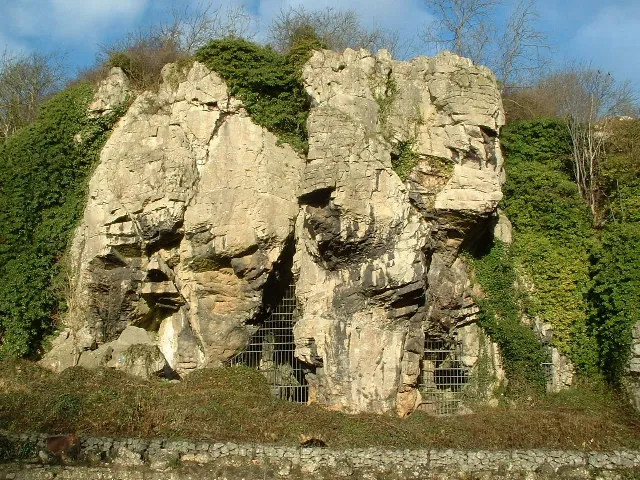Creswell Crags is a limestone gorge dotted with caves and smaller fissures. It’s situated on the border between Derbyshire and Nottinghamshire in the UK. Famous for its Paleolithic archaeology, the site boasts evidence of human activity dating back around 43,000 years. It’s a treasure trove of history, with Ice Age art, ancient animal remains, and tools discovered within its caves. Creswell Crags serves as a window into the lives of our distant ancestors, offering insights into their daily lives, survival strategies, and artistic expressions.
Get your dose of History via Email
Historical Background of Creswell Crags
The discovery of Creswell Crags dates back to the 19th century. Initially, it drew interest for its Pleistocene fauna. Archaeologists like William Boyd Dawkins and J. Wilfrid Jackson excavated the site, uncovering its rich history. They found tools, animal bones, and evidence of human habitation. The caves were a seasonal home to nomadic groups during the Ice Age. Later, they served as a canvas for prehistoric artists. Creswell Crags has not been the scene of major historical events. Yet, it holds key insights into prehistoric life.
The caves at Creswell Crags were carved naturally over millions of years. Humans never built them, but they certainly made them their own. The first known inhabitants were Neanderthals. They left behind tools and relics. Then, modern humans took over, leaving more sophisticated items. These finds suggest Creswell Crags was a hub of activity during the Upper Paleolithic period.
Over time, Creswell Crags has seen various uses. In the medieval period, some caves served as hermitages. Local legends even speak of them being used by outlaws like Robin Hood. However, these tales are more myth than history. The site’s true importance lies in its prehistoric significance.
Creswell Crags gained recognition for its Paleolithic art in 2003. Researchers discovered engravings and bas-reliefs on the cave walls. These artworks are among the oldest known in the British Isles. They depict animals, abstract patterns, and possibly, the human form. This discovery elevated Creswell Crags’ status in the archaeological community.
Today, Creswell Crags is a protected heritage site. It’s a place of ongoing research and public education. The site offers tours, exhibitions, and educational programs. These initiatives help to share its stories with the world. Creswell Crags continues to fascinate both the scientific community and the public at large.
About Creswell Crags
Creswell Crags consists of a limestone gorge with numerous caves and rock shelters. These natural formations resulted from water erosion over millions of years. The caves vary in size and depth. Some are large enough to walk into, while others are mere crevices. The limestone that forms Creswell Crags is rich in fossils, providing a glimpse into ancient ecosystems.
The most notable caves at Creswell Crags include Robin Hood’s Cave, Church Hole, and Pin Hole. Each cave has unique features and archaeological significance. Robin Hood’s Cave, for instance, yielded a wealth of artifacts. These include tools, jewelry, and the remains of Ice Age animals.
The caves were not constructed but were naturally formed. However, humans modified them to suit their needs. They used fire to create a livable environment. They also left behind carvings and wall art. These modifications provide valuable insights into their capabilities and culture.
Architectural highlights are scarce, as the caves are prehistoric and unstructured. Yet, the presence of art within Church Hole Cave stands out. The engravings and bas-reliefs represent a sophisticated level of human expression. They suggest a complex understanding of the world and a desire to communicate or record experiences.
The building materials for any human modifications were what was naturally available. Stone and bone tools were used to carve into the soft limestone. The caves’ interiors bear the marks of these tools. They show how our ancestors shaped their environment to their needs.
Theories and Interpretations
The purpose of Creswell Crags has been the subject of much speculation. The most widely accepted theory is that it served as a seasonal encampment. Here, hunter-gatherers could find shelter and resources. The presence of animal bones suggests hunting was a primary activity.
Some mysteries surround Creswell Crags, particularly the meaning behind the cave art. Researchers debate whether these images had a symbolic purpose or were simply decorative. The art’s exact age is also a topic of discussion. Dating techniques like radiocarbon dating have been employed to estimate the age of artifacts and art.
Interpretations of the site have evolved over time. Initially, Creswell Crags was thought to be a mere hunting ground. Now, it’s recognized as a significant cultural and spiritual site. The art suggests that the caves may have held ritual significance for their creators.
Dating of the Creswell Crags site has employed methods such as uranium-series dating and radiocarbon dating. These techniques have helped establish a timeline for the occupation and use of the caves. They have also been used to date the cave art, placing it within the Upper Paleolithic period.
Theories continue to develop as new discoveries are made. Creswell Crags remains an active archaeological site. Each find adds a piece to the puzzle of our human story. The site challenges our understanding of prehistoric life and culture.
At a glance
Country: United Kingdom
Civilization: Neanderthals and Upper Paleolithic modern humans
Age: Approximately 43,000 years old
Conclusion and Sources
The information in this article has been obtained from the following reputable sources:

